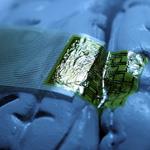

The brain, with its many folds and ridges, has the most convoluted surface of any organ in the body. But the implants currently used to monitor brain waves are rigid and only slightly flexible, making them a poor match to the brain’s irregular surface.
That is all about to change. John Rogers, a professor of chemistry and materials science, recently announced the development of a fully conformal electronic brain implant that molds itself to the brain, hugging the surface like a sheet of plastic wrap. The implant consists of 30 electrodes on an ultrathin base in the layout of an open mesh.
The device, which measures and monitors electrical signals from brain cells, could make it possible to predict the onset of an epileptic seizure before it happens. “There’s also the idea that if you can stimulate the brain using those same electrodes, or some version of that technology, then you can eliminate the seizure entirely,” says Rogers, who is known worldwide for his work on flexible, stretchable electronics.

A key innovative feature of the device is its temporary substrate made of silk. The silk material provides support for the mesh electrodes, allowing them to be easily manipulated for mounting on the brain. By washing the device with a saline solution, the silk is dissolved in a “resorbable” process similar to sutures that dissolve. This leaves the mesh adhered to the contoured surface of the brain.
“With this process, we can use a very thin, conformal, mechanically ‘floppy’ design for the electrodes, but in a format that also enables easy handling by surgeons,” he says.
For the past decade, the primary focus throughout the industry has been on flexible devices for consumer products—electronics that can mold into the folds of fabric or sheets of plastic. But Rogers says he always had a sense that this technology might have important uses in the human body.
He traces the genesis of these medical efforts back to a talk he gave on flexible electronics at the University of Pennsylvania several years ago. Two graduate students in bioengineering approached him after his talk, excited about the possible uses of flexible devices in the brain. The result has been a collaboration with the University of Pennsylvania School of Medicine on projects dealing with both the heart and brain. In addition, Tufts University has been involved with the bioresorbable aspect of the project.
“The argument is simple,” says Rogers. “The human body is soft and elastic and curvilinear, while silicon wafers are not. If you can create an electronics technology that is more compatible to the human body, then you can bring high-quality electronics to bear on all kinds of problems in human health.”
The brain poses especially tough challenges, with all of its folds and fissures. But Rogers says their thin electronics array successfully molds to the brain’s intricate shape.“We even have devices that can fold up and insert into the gap between the right and left hemispheres, so you can monitor electrical activity on both inner surfaces at the same time,” he says.
In tests, their brain implant has been able to successfully record activity in the brain’s visual center in response to visual stimulation. In fact, it has been able to capture stronger signals than the thicker, rigid brain implants.
Current high-performance implants are needle-like electrodes that can penetrate deep into brain tissue, while the new flexible device lacks sharp electrodes, improving safety and posing less risk to brain tissue, Rogers says.
But this is just the beginning, he points out. For people with spinal cord injuries, he envisions that the technology could be used to read the complex brain signals that direct movement. Then those signals could be routed to healthy muscles or to prosthetic devices.
“We are aiming our research directly toward technologies with potential for clinical use and are hopeful that a successful outcome will yield significant benefits to human health,” he says. “There are a lot of areas in which ultrathin electronics will be useful, either on the surface or inside the body.”


